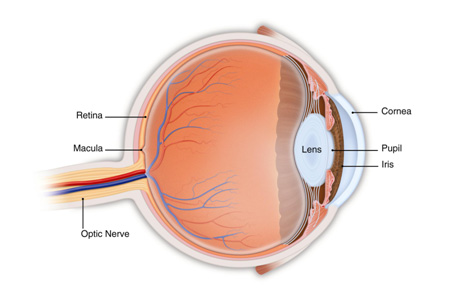Light rays enter the eye through the clear cornea, pupil and lens. These light rays on focused directly onto the retina, the light-sensitive tissue in the back of the eye. The retina converts light rays into impulses, which are then sent through the optic nerve to the brain where they are recognized as images.
 Anatomy of the Eye
Anatomy of the Eye
Cornea- The cornea is the clear front window of the eye. It covers the iris and the round pupil. The cornea is responsible for 70% of the eye’s focusing power. The cornea is composed of five layers:
- Epithelium
- Bowman’s Membrane
- Stroma
- Descemet’s Membrane
- Endothelium
See Corneal & External Disease
Iris- The iris is the colored part of your eye that is located behind the cornea.
Pupil- The pupil is the round, black opening in the center of the iris. The pupil controls the amount of light entering the eye. During eye exams, your doctor may need to instill eye drops to dilate your pupils. This allows the doctor to examine the back of the eye. Dilation can last anywhere from a few hours to a few days. It is common for patients to experience light sensitivity and blurred vision while dilated.
Crystalline Lens– The crystalline lens is a clear structure located behind the iris. The lens works with the cornea to focus light. When looking at a distant object, the lens is flat. When we need to see up close, the lens will flex. This flexing motion is also known as accommodation. Common conditions involving the lens are Presbyopia and Cataracts.
Retina- The retina is a light sensitive tissue which lines the back of the eye. The retina allows the image to be “seen” by the brain. See Retina and Vitreous
Macula- The macula is a yellow, oval-shaped spot in the center of the retina. The macula is responsible for central vision and allows us to perform activities such as reading and driving. Macular Degeneration is a leading cause of poor vision is people over the age of 60.
Optic Nerve- The optic nerve transmits visual information from the retina to the brain.








